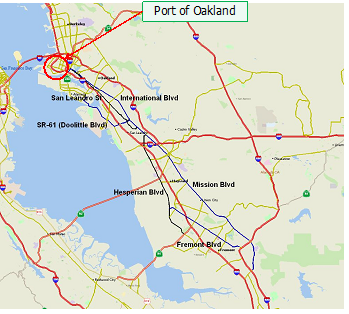As part of this research effort, the project aims to investigate how the extension of operating hours of ports will affect the energy use and emissions at the system level. Though implemented by several seaports across the US, how the extended operating hours of port affect the energy efficiency of the freight system remains unaddressed. The Port of Oakland, California, was used to gain insight into the effects of changing work hours on fuel consumption. Ports are critical supply chain nodes that attract a high volume of freight vehicles which can generate congestion, and consequently affect the fuel consumption of all the vehicles in the surrounding areas. Typically, indirect impacts generated by ports, like the increase in fuel consumption mentioned, are not taken into consideration. The results obtained with the simulation of the Port of Oakland can provide insights to other port authorities across the country.

There are two ways that changing ports’ operations can reduce traffic congestion in the surrounding area:
Shifting or extending ports’ work hours: it allows trucks to access the port before or after peak traffic hours, reducing traffic congestion
Implementing a booking system for trucks: it staggers the arrival of trucks to the port and spread traffic across the day, also avoiding peak congestion.
A traffic microsimulation system of the I-880 corridor considering passenger and freight vehicles was calibrated to assess the impacts of such changes in work hours and traffic patterns. Seven scenarios were simulated:
Stagger the arrival of trucks in current work hours
Shift work hours by 2 hours
Shift work hours by 4 hours
Extend work hours by 3 hours in the evening
Extend work hours by 3 hours in the evening and stagger the arrival of trucks
Extend work hours by 3 hours in the morning
Extend work hours by 3 hours in the morning and stagger the arrival of trucks
All the simulated scenarios showed there would be a reduction in fuel consumption when compared to the base case (Figure 2). The scenarios with greater fuel savings include the implementation of an appointment system to stagger the arrival of trucks to the port. The scenario that indicates the largest fuel savings (1.393%) includes staggering the arrival of trucks and extending work hours 3 hours in the evening. Overall, these results confirm the importance ports’ work hours play in fuel consumption of the surrounding traffic and could be used as insights for policy makers in other locations.

